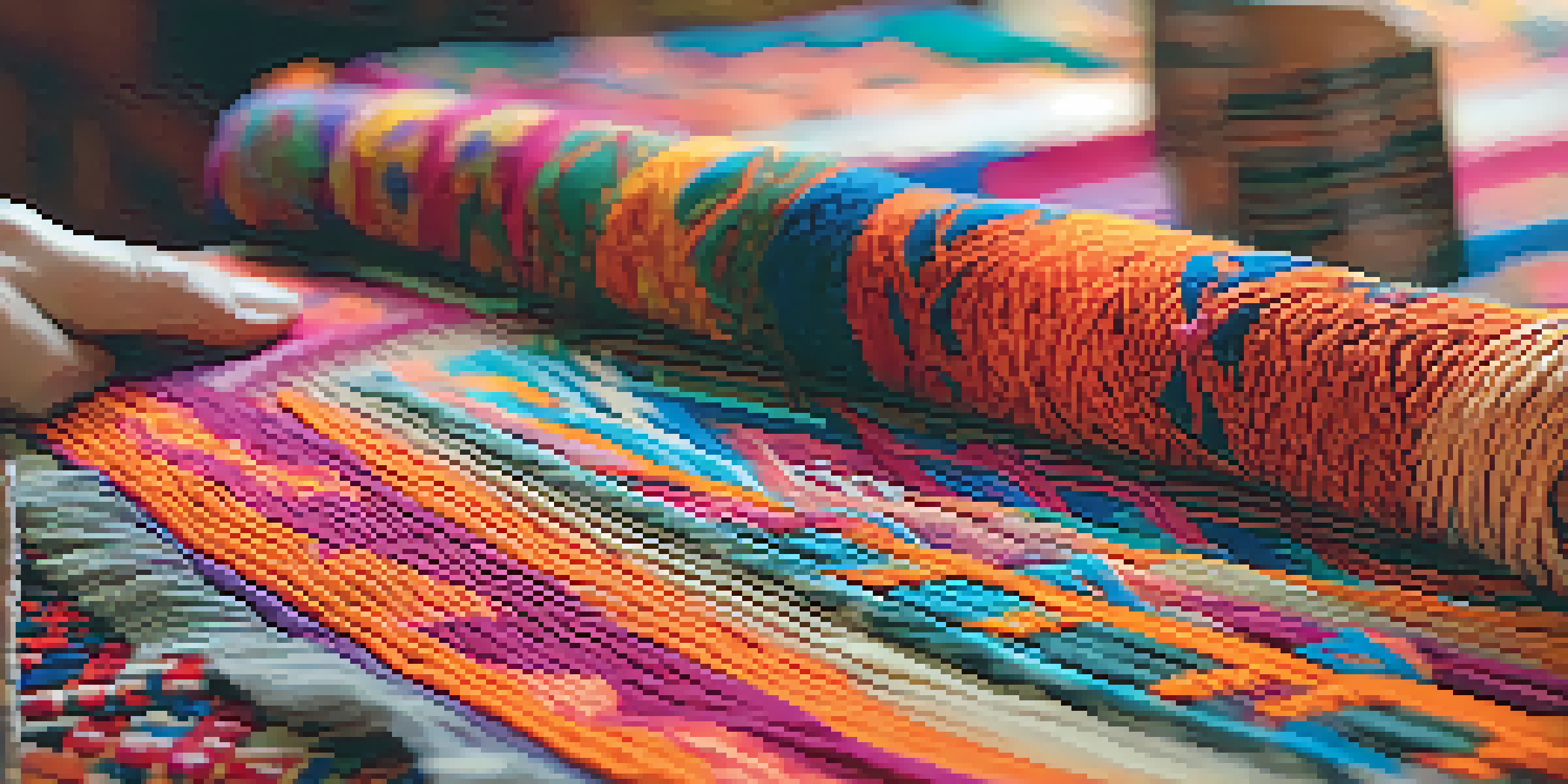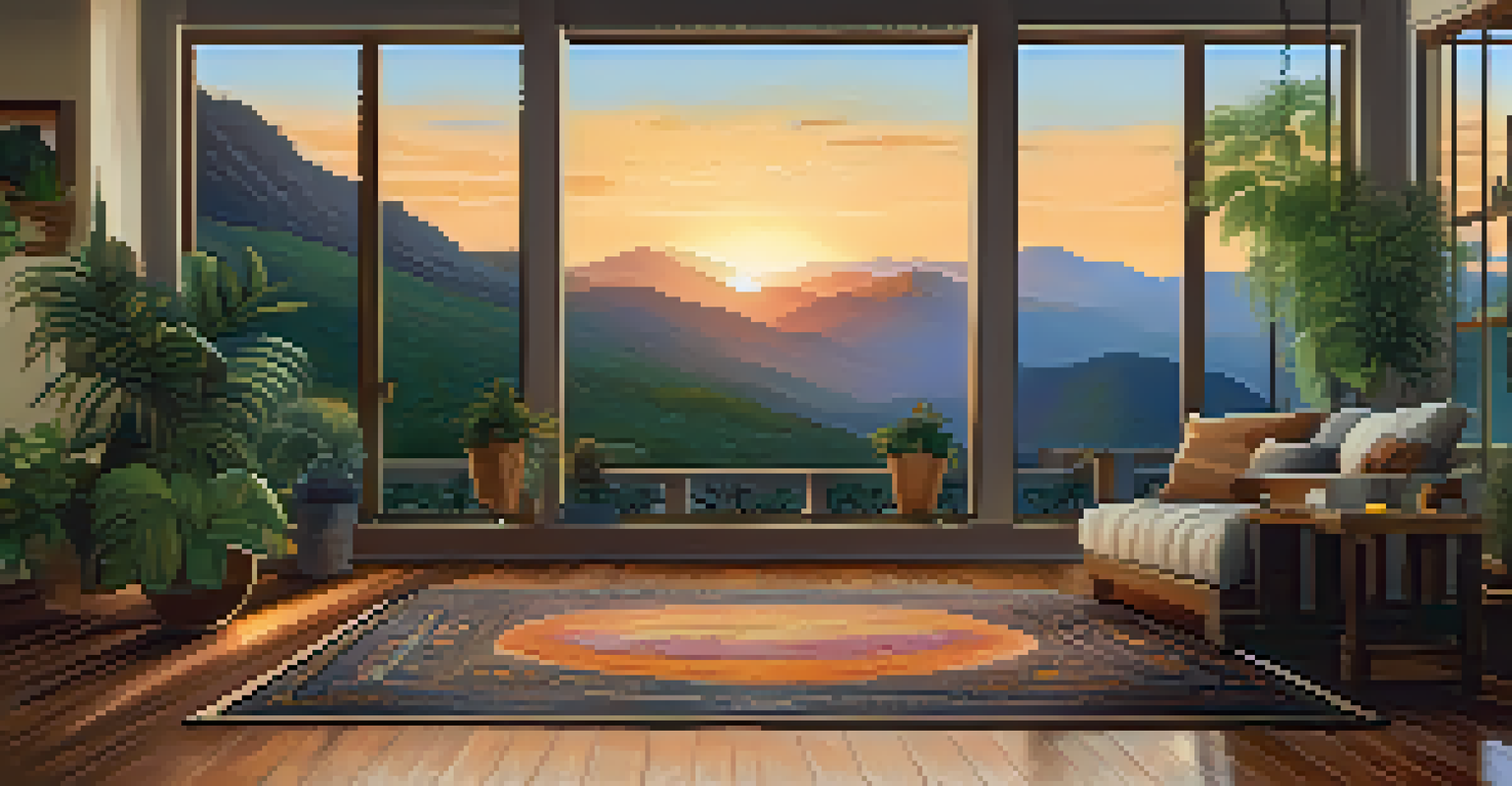Weaving Techniques for Beautiful Handmade Rugs and Carpets

Understanding the Basics of Weaving Techniques
Weaving is an age-old craft that transforms threads into beautiful textiles. At its core, it involves the interlacing of yarns to create patterns and textures. Whether you're a novice or a seasoned artisan, grasping the basics is crucial for crafting stunning rugs and carpets.
Weaving is not just a craft, it's a way of telling stories through the threads we choose.
Various techniques can be employed, each producing unique results. These can range from simple over-and-under patterns to more complex methods like knotting and looping. Understanding these foundational techniques will empower you to explore your creativity and experiment with designs.
As you dive into weaving, think of it like painting with yarn. Each technique offers a different brushstroke, allowing you to express your style. Armed with this knowledge, you're ready to embark on your weaving journey.
Exploring the Art of Knotting Techniques
Knotting techniques are among the oldest and most revered methods in rug making. The most well-known of these is the Persian knot, which creates a durable and intricate design. This technique involves tying individual knots around a base thread, resulting in a dense and textured surface.

Another popular knotting method is the Turkish knot, which is slightly more straightforward but equally effective. It yields a soft, plush feel, perfect for cozy rugs. Each type of knot brings its own charm and flair, allowing you to tailor your creation to suit your aesthetic.
Master Weaving Techniques
Understanding various weaving techniques, like knotting and looping, is essential for creating unique and beautiful textiles.
When choosing a knotting technique, consider the final look you desire. Just like choosing a recipe for a dish, the right technique will enhance the beauty of your handmade rug. Experimenting with these knots can lead to stunning, one-of-a-kind pieces.
The Versatility of Looping Techniques
Looping techniques offer a playful twist to traditional weaving methods. Instead of creating a flat surface, this style results in a textured, three-dimensional effect, perfect for adding depth and interest to any rug. The loops can be tight or loose, creating a variety of visual outcomes.
Creativity is contagious, pass it on.
One popular looping method is the cut-loop technique, which combines both cut and uncut loops. This approach allows for a dynamic design, where certain areas are plush while others remain flat. It's a fantastic way to create patterns and textures that catch the eye.
Think of looping like creating a landscape with rolling hills and valleys. The variations in height can transform a simple rug into an artistic statement piece. By mastering looping techniques, you can elevate the design of your handmade carpets.
Using Tapestry Weaving for Unique Designs
Tapestry weaving is a captivating technique that allows for intricate imagery and patterns. Unlike traditional weaving, where the focus is on texture, tapestry focuses on the narrative conveyed through colors and shapes. This technique is perfect for artists looking to tell a story with their rugs.
In tapestry weaving, the weaver carefully selects colors and threads to create detailed images. This method requires precision and patience, as each row is meticulously crafted. The result is a stunning piece that can serve as a focal point in any room.
Importance of Color Theory
Incorporating color theory into your weaving projects enhances the visual appeal and emotional connection of your handmade rugs.
Imagine creating a rug that resembles a beautiful painting. That’s the magic of tapestry weaving! By exploring this technique, you can infuse your personality and artistic flair into your handmade carpets.
Mastering the Craft of Flat Weaving Techniques
Flat weaving techniques, such as kilim and soumak, are celebrated for their streamlined beauty and durability. These methods create flat rugs without knots, resulting in a lightweight and versatile product. They're perfect for areas with high foot traffic, offering both style and practicality.
Kilim weaving features bold geometric patterns and vibrant colors, making it a favorite for modern interiors. In contrast, soumak adds texture through its unique looping method, creating a slightly raised effect. Both techniques allow for endless creativity and customization.
Think of flat weaving as crafting a canvas for your home decor. The choices of colors and patterns can reflect your personal style, making the rug a true representation of your taste. By mastering flat weaving, you can create beautiful, functional pieces that enhance any space.
Incorporating Color Theory in Weaving
Color theory plays a vital role in weaving, influencing the mood and aesthetic of your rugs. Understanding how colors interact can help you create harmonious designs that resonate with your audience. Warm colors can evoke feelings of coziness, while cool colors promote calmness.
When selecting colors for your weaving project, consider using a color wheel as a guide. Complementary colors can create striking contrasts, while analogous colors can provide a more soothing palette. The right combination can transform a simple rug into a captivating work of art.
Care for Handmade Rugs
Regular maintenance and proper cleaning techniques are crucial for preserving the beauty and longevity of your handmade carpets.
Imagine your rug as a canvas where color tells a story. By thoughtfully incorporating color theory into your designs, you not only enhance the visual appeal but also create an emotional connection with viewers. This makes your handmade carpets not just functional, but a true expression of artistry.
Caring for Your Handmade Rugs and Carpets
Once you've mastered the art of weaving, caring for your handmade rugs is essential to preserve their beauty. Regular cleaning and maintenance can prolong the life of your carpets, ensuring they remain vibrant and fresh for years. Start by vacuuming regularly to remove dirt and debris.
For deeper cleaning, consider professional services or specific cleaning techniques suited to your rug type. Always test cleaning products on a small area first to avoid damage. Additionally, rotating your rugs periodically can help prevent uneven wear from sunlight or foot traffic.

Think of caring for your rug like tending to a garden; regular attention can promote growth and longevity. By treating your handmade carpets with love and care, you'll keep their charm intact, allowing them to be enjoyed for generations to come.
Finding Inspiration for Your Weaving Projects
Inspiration can strike from the most unexpected places, and weaving is no exception. Nature, art, and even architecture can fuel your creativity, leading to unique designs that reflect your personal style. Don't shy away from exploring various sources to spark new ideas for your rugs.
Social media platforms and online communities are also fantastic resources for inspiration. Platforms like Pinterest and Instagram are filled with stunning visuals and innovative techniques that can ignite your imagination. Engaging with other weavers can also provide fresh perspectives and ideas.
Imagine your weaving journey as a treasure hunt for creativity. By seeking inspiration, you not only enhance your skills but also uncover your unique artistic voice. So, grab your materials and start weaving, because the possibilities are endless!